By 2026, about a quarter of all purchases will take place online.
If you sell any type of products to any type of customers, that should get your attention. Online selling is only going to grow but it’s bound to be more challenging to stand out.
A good ecommerce strategy can help your business emerge from the pack. Whether you’re about to take your brick-and-mortar business online for the first time or launch your next brand, an ecommerce strategy will help you hit goals and stay ahead of competitors. This guide has everything you need: steps, tips, and examples to help you build and execute a successful ecommerce strategy.
What is an ecommerce strategy?
An ecommerce strategy is a set of plans and activities businesses use to sell products or services online. This includes reaching the right people, converting them into customers, generating repeat purchases, and creating a smooth, enjoyable shopping experience.
The best ecommerce strategies are comprehensive and reliable. They’re easy to follow and give you confidence for big projects like ecommerce expansions.
Why is it important to have an ecommerce strategy plan?
Just like a business plan or a marketing strategy, having a roadmap for your ecommerce business can set you up for success. There are four key benefits to having an effective ecommerce strategy:
1. Long-term company health and stability
An ecommerce strategy gives you a consistent stream of new customers and a way to turn one-time shoppers into loyal repeat buyers. It gives you a blueprint for launching a new product line, a holiday campaign, or a new market.
Having an ecommerce plan means you can weather dips in website traffic or revenue. Not only will you know what caused them—you’ll know what to do to get back on track. The result? A stable, resilient company with happy employees.
2. Foundation for scalability and growth
By definition, ecommerce strategies are made to help you grow, whether that’s expanding from retail into omnichannel selling or growing your current ecommerce business.
The magic is in knowing what to do when those opportunities arise.
Should you hire more staff, and how many? Could a brick-and-mortar store increase the success of an ecommerce launch? What do you have to do to thrive in a new country or continent? How can your brand be the go-to option based on what’s working in your target market? Ecommerce planning helps answer those questions, and more.
3. Ability to edge out competition
Competitor research is a big part of an ecommerce business strategy. It allows you to develop your unique value proposition, intentionally position yourself in the market, and stand out from your competitors while giving your target customers exactly what they want.
4. Operational and cost efficiency
Being strategic about your ecommerce operations lets you optimize your inventory management, supply chain processes, tech stack, order fulfillment, and every moment in the customer journey.
You’ll avoid hidden costs, minimize errors, and maximize productivity throughout the business so you can stay operationally lean and serve your customers well.
How to create an ecommerce strategy plan
It can be hard to know where to start when developing your ecommerce strategy plan, but these six steps will help you know what to consider and what data you need to gather.
-
Get to know your ideal buyer
-
List marketing channels and customer touchpoints
-
Define your goals and objectives
-
Get to know your competitors
-
Develop your unique value proposition
-
Map out the system and tools you need
1. Get to know your ideal buyer
Your ecommerce brand’s success is a reflection of how well you match what your target customers want and what they need. Understanding them is essential to everything you do.
Buyer personas, or profiles of ideal customers, often have details like location, gender, age, and interests. But it’s easy to make the mistake of stopping there. To meet the needs of your target audience, you should ask them:
-
What are their needs?
-
What is the pain point they’re frequently dealing with?
-
What would make them search for a product like yours?
-
How do they search for new products: online, asking a friend, in person, or a mix?
-
What criteria do they use when making a purchase decision? Budget, ease of product use, shopping experience, or something else?
Underwear brand Pepper creates bras that fit small-chested women. The main struggle of this target audience is finding flattering, comfortable bras. Pepper wins by showing a deep understanding of this issue and offering a solution to it, regardless of the age or specific interests of its audience.
The key is in continuously learning about your target customer and knowing how you can add more value into their lives.
2. List marketing channels and customer touchpoints
Diving deep into your target customer’s struggles and motivation will help you unpack another crucial element: where they research, compare, and shop for solutions.
There are many ways you can figure this out, including interviewing customers, using audience intelligence tools, monitoring forums and social media channels, and tapping into data from Shopify’s Commerce Trends 2023 report.
If you have an ecommerce site, you can dig through your Google Analytics reports and use platforms like Daasity, to analyze all touchpoints your customers go through, including social media, emails, marketplaces, and more.
This will help you build a customer journey map, which unlocks what your customers need on every channel and at every stage of their buying process, so you know where to focus your efforts.

Example of a customer journey map.
3. Define your goals and objectives
What are the key performance indicators (KPIs) you’ll use to track the success of your ecommerce store or your newest launch? What do you want to achieve, both now and in the long run?
Here are some goals to consider:
-
Total number of sales
-
Total revenue
-
Number of new customers
-
Number of repeat customers
-
Average order value
-
Market share percentage
Lean on your past performance to set goals that are both ambitious and realistic, and check in with your analytics regularly to make changes to them, if necessary. Don’t forget to define and track leading indicators, as they’ll give you instant feedback and a chance to course correct.
4. Get to know your competitors
Spend some time analyzing your competitors. This isn’t to copy their activities—after all, you don’t know what’s working for them—but to gain insights into trends, opportunities, challenges, and the industry as a whole. That’s what lets you carve your own space in the customer’s eyes.
Spend time browsing your competitors’ social media profiles, product pages, blog articles, and emails, and take notes on what they’re doing. What stands out to you? Note gaps or opportunities you see.
You can also use the publicly available data social media platforms offer, like the audience insights provided by TikTok and Facebook.
You can run your own analysis on each relevant competitor, meaning you’re looking at their strengths, weaknesses, opportunities, and threats (SWOT). If you were analyzing a fellow online shirt business, here’s a sample SWOT matrix:

Example of a SWOT analysis matrix for an online shirt business. (source)
5. Develop your unique value proposition
Your unique value proposition is what sets you apart from competitors. It needs to resonate with your customers and give them the reason to choose.
Underwear brand Pepper nailed its unique value proposition by saying it makes bras that finally fit small-chested women. It differentiates itself from other brands that don’t serve this audience, or don’t do it well.
Accessories brand The Ridge positions itself as the minimalist, RFID-blocking wallet with a lifetime guarantee, helping it stand out from standard wallet brands.
Kids brand Ten Little aims to make shopping for little ones easy by offering items based on their size and stage, separating it from other ecommerce stores’ shopping experience.
These ecommerce brands have developed resources—quizzes, shopping guides, social media posts—that support their unique value proposition. They help grow their reach by turning visitors into customers and customers into loyal brand ambassadors.
Matt Scanlan, CEO of knitwear brand NAADAM, says it takes time and focus to build an intentional and effective value proposition.
“I think it takes having something unique about that proposition, whether it’s quality or supply chain or intention,” he says. “I think we know that if we just keep our heads down and just keep on doing what we know we do better than other people, then at least we have a chance to do it right.”
Not sure where to start with your unique value proposition? One of Shopify’s more than 75 brand strategy and brand identity partners can help.
6. Map out the systems and tools you need
It’s important to define the tech stack you need to attract new customers, convert them, fulfill orders, manage your inventory, and seamlessly execute your ecommerce marketing strategy.
You might already be using these, but here’s a list you can refer to when building your suite of ecommerce systems and tools:
-
Online store: features like product pages, rich visuals, and a smooth checkout process
-
Omnichannel selling: enable buying through social media channels and marketplaces; offer purchase options like buy online, pickup in-store or buy in-store, ship to customer
-
Payment options: let customers pay securely using different payment providers or digital wallets
-
International ecommerce: run an online store tailored to locations with international domains, custom duties and taxes, and custom pricing
-
Supply chain management: monitor your inventory, fulfill orders, coordinate shipping and returns from an integrated platform (consider a third-party logistics partner you can integrate with your ecommerce software)
-
Customization: launch custom campaigns, tag customers, send back-in-stock notifications, personalize your checkout, and more with automations and workflows
Ideally, what you need from your tech stack will be included in your platform of choice, with easy and straightforward integrations to build on.
Ecommerce strategy best practices and tips
Need ideas and tips for your ecommerce strategy plan? Learn tactics and tips to achieve your specific ecommerce goals.
Ecommerce strategies for attracting new customers
All customer acquisition strategies come down to growing your organic reach and tapping into an existing audience.
You can reach people organically through social media, through search engine optimization (SEO), or by partnering with a creator or another business to reach their audience. Here are three strategies and examples of brands that use them well.
1. Get active and consistent on social media
Social media is crowded and it can be difficult to stand out. When you tap into your unique value proposition and use it to improve customers’ lives, your content reaches new people every day.
Take it from Pashion Footwear, a brand that sells convertible heels. Its TikTok has more than 200,000 followers, and its videos reach 20,000 to two million people. It focuses on the problem these shoes solve and uses trending audios and video concepts.

Pashion Footwear’s TikTok profile. (source)
Want to sell through social media platforms like TikTok, Instagram, and Pinterest? You’ll love Shopify’s omnichannel commerce superpowers.
2. Reach the right people through search engines
Putting efforts into SEO might be one of the best long-term investments you can make. When product pages or guides rank at the top for the terms your customers are looking for, you become their go-to option. If you stay there for months or years to come, you become the brand everyone knows about.
Skin care brand Biossance, knows the power of a search-optimized product page. It takes up the top organic spot for the search term “vitamin c rose oil,” which people search for almost 600 times per month.

Biossance’s organic search result.
That’s just one product page and one search term. Doing this for dozens or even hundreds of products can become a key tactic for growing your customer base.
If you want to add strategic SEO to your ecommerce plan, check out Shopify’s SEO partners, who can help you hit your goals.
3. Partner with influencers that align with your goals and values
Influencer marketing is estimated to reach a $21.1 billion market size in 2023, and it’s not just about influencers with millions of followers.
If there’s a creator with a thousand followers that has built a strong connection with their followers—and they match your tone and values—it’s worth partnering with them to reach their audience.
Your products don’t need to be the main focus of the social media post for them to reach new audiences. Take it from fitness and activewear brand AYBL. It partners with fitness creators like Madison Hoover, which mentions the brand organically as part of its workout routine videos.
Madison Hoover’s TikTok video that features AYBL in the caption. (source)
Ecommerce strategies for converting customers
What can you do to convert readers, viewers, and visitors into customers? Here are five tactics to add to your ecommerce strategy.
1. Optimize your product page for success
A product page should give a shopper everything they need to add a product to their cart.
How to do it? Include all relevant information about the product in a way that’s easy to browse and navigate. This includes product details, shipping and return options, and customer reviews. The more specific you can get, the better.
That’s what Australian flower delivery brand and Shopify merchant LVLY did. Aside from a detailed product description, its product pages show a size guide, options to add related items, and a long list of reviews visitors can filter based on rating and use case.

LVLY’s product page with sizing options and reviews.
LVLY now offers a smooth experience to customize products and offer more than 150 different types of bundles. Check out how the LVLY team did it with the Shopify Plus plan.
2. Optimize your checkout process
How easy is it to complete a purchase on your ecommerce website? How smooth and delightful is the journey you’re sending your customers on?
The answers will define how happy or frustrated customers feel by the time they reach the thank you page—and, as a result, how excited they’ll be to receive your products, tell their friends about them, and buy from you again.
Eyewear brand Peepers created a customized checkout process that has helped it boost sales. As customers add products to their cart, a sidebar pops up with product details, a subtotal, and additional recommended items.
After improving the shopping journey, Peepers started converting more organic visitors into customers, increasing its average order value to $55 and its customer lifetime value to $165.

Peepers’ product category page with a checkout bar on the side.
3. Reward customers with free shipping
Free shipping and freebies play a huge role in converting visitors into customers. Shopify’s Commerce Trends 2023 report revealed customers order more items and spend more money with free shipping.
The key to conversion is in making the free shipping threshold obvious and reasonable. If someone needs to add a dozen products to the cart to reach it, it won’t have the desired effect.
Take it from Western boots and accessories brand Tecovas. Its checkout shows a progress bar that motivates customers to reach the free shipping threshold. There’s also a reminder they can get a free product if they meet cart requirements—like a belt when customers buy a pair of boots.

Tecovas’ product page with a checkout bar on the side.
4. Offer discounts that win customers and grow your revenue
Discounts allow shoppers to buy products at a lower price through sales, coupon codes, or bundles. Ecommerce businesses use discounts often because it’s a quick way to generate more sales than usual.
You can offer discounts on specific items, give a buy one, get one (BOGO) deal, offer volume discounts, promote a time-based discount code, and more.
The challenge is to do it in a way that doesn’t devalue your products, anger customers who purchased at full price, or slow down sales because people are waiting for a discount.
Gym wear brand Women’s Best uses discounts to incentivize shoppers to buy leftover inventory at the end of a season. The timing is ideal for the brand, so they can sell items before they stock up on new product lines and increase sales, and customers can get a deal on outlet items.
To encourage customers to browse and buy these products, the brand offers extra 15% off on the entire cart value if the customer buys an outlet product.

Women’s Best outlet discount email campaign.
5. Send emails that turn abandoned carts into revenue
According to Baymard Institute, 69% of all online shopping carts are abandoned. Sometimes, that’s because people are exploring and researching their options. Baymard’s report found shipping costs and taxes, having to create an account, slow delivery, and a complicated checkout process are other major reasons
That’s why cart abandonment emails are essential for converting potential customers. They serve as a reminder, and you can use them to add an incentive like a discount code or free shipping.
The best part is you can customize your cart abandonment emails.
Here’s what an abandoned cart reminder looks like for Braxley Bands, a brand that makes comfortable Apple Watch bands. It looks like a regular email, has a bold tone, feels personal, and rewards the customer for taking action.

Braxley Bands’ cart abandonment recovery campaign.
Whatever style of cart recovery emails you choose, you can run experiments to find what brings the best results. If you don’t know where to start, one of Shopify’s marketing automation partners can help.
Ecommerce strategies for retaining customers
Let’s dive into customer retention best practices and what you can do to generate customer loyalty.
1. Check in with customers after a while
Send personalized emails to customers based on what they’ve bought in the past or what they’ve recently browsed on your website.
You can send them a reminder to reorder their products before they run out, a shopping guide for the product category they were browsing recently, or testimonials for a product that complements what they already have.
Curly hair brand Curlsmith makes it easy for customers to reorder their favorite products. It also recommends products that work well with their previous order and invites customers to tag them on social media with their results.

Curlsmith’s check-in and replenishment reminder email.
2. Build and maintain a loyalty program your customers will love
A loyalty program is a way to reward your customers for trusting you with their time, money, and energy. In exchange for the points they’ve collected by buying from you, you can give them exclusive discounts, free products, early product releases, limited edition products, and more.
Check in with your loyal customers often. Remind them to redeem their points (and what they get in return), tell them how to collect more, and nudge them toward the products and categories they’ve bought most frequently.
Another curly hair care company, Bouclème, sends a short and sweet loyalty program email. It’s simple but offers value to customers. This example shows the customer they have £30 (around $37) worth of points to be redeemed.

Bouclème’s loyalty points email.
3. Let customers subscribe to a recurring delivery of the products they want
Ecommerce subscriptions benefit everyone involved. Customers know they won’t run out of products they love, and you get predictable revenue plus customers with higher lifetime value.
If you have replenishable products in your store, consider offering a recurring subscription.
Stay Flexy is a direct-to-consumer (DTC) brand run by David Thurin, the creator of the MovementbyDavid YouTube channel. When ordering from Stay Flexy, customers can choose a one-time purchase or a subscription option, which lets them choose a 30-, 60-, or 90-day delivery cycle and takes 15% off product price.

Stay Flexy’s product page with product subscription options.
Ecommerce strategies for creating a smooth customer experience
When you delight customers at every touchpoint, it paves the way to becoming their favorite brand. Here’s what you can do to make that happen.
1. Fulfill and ship your orders quickly
Underpromise, overdeliver—the strategy of setting expectations and then knocking them out of the park—works well in fulfilling ecommerce orders.
The promise is easy, but the challenge is in the overdelivering.
Will your products arrive when you said they would? Will all of them be included and packaged correctly? As you grow and have to send more orders, will you keep the quality of your fulfillment and customer experience as a result?
Popular hot sauce brand Heatonist struggled with this. It used to include handwritten notes in every order, but as it grew, this became harder to do, and orders often had wrong or damaged items.
Heatonist worked with fulfillment centers across the country to offer guaranteed three-day shipping, and zero fulfillment delays. How did the Heatonist team make it happen? By using the Shopify Fulfillment Network.
It made sure the presentation of the products matched the company’s standards and improved customer experience.

Heatonist’s homepage.
Put your brand front and center with every order with Shopify’s shipping and fulfillment capabilities—and exceed expectations with every order.
2. Tailor your website to the customer’s location
Buying from a merchant that isn’t in your country can be a challenge if shipping requirements aren’t clear.
That’s why it’s important to be transparent from the very first touchpoint with a visitor. It means letting them select the language and currency to shop in, as well as showing them shipping rates and timelines. If you’re not yet shipping to their country, show them a pop-up to let them know instantly.
Wallpaper brand Hygge & West makes international shopping smooth and worry-free. Visitors instantly see duties and taxes for their country, which reassures the customer the brand ships to them and shows transparency on how duties work.

Hygge & West’s homepage with a location-specific pop-up.
Hygge & West made this happen by using Zonos, a Shopify app that gives international shoppers a better experience. Learn how you can sell and grow globally with Shopify and its international ecommerce features.
3. Personalize the shopping journey
Helping your customer find exactly what they need saves them time, but also improves their satisfaction. Getting to know your customers and using what you’ve learned to recommend products gives you an advantage.
There are many ways to collect those insights, like looking at a customer’s previous purchases and reviews. But you can also be proactive. Skin care brand Skin Inc offers a skin identity check—a survey examining the shopper’s skin condition and frustrations to recommend a skin care regimen that matches their needs.

Skin Inc’s skin quiz results.
Skin Inc also uses customer insights to inform sales events, marketing tools, and its loyalty program. Since implementing these changes with Shopify, Skin Inc’s revenue quadrupled, conversion rates doubled, and return business has increased by 15%.
4. Run a smooth, enjoyable return process
How you handle ecommerce returns can make a big difference to how customers feel about your brand and whether they’ll buy from you again. A 2022 survey found that 96% of customers would buy from a brand again if it was “very easy” to return items.
Buying online is always a risk—sizing, colors, fit, style, and so many other factors can make even your most popular products not work for a customer. It happens even when your product pages offer sizing charts, virtual try-ons, videos, and buying tips.
A smooth return process is the key to bridging risk and giving customers confidence to buy from you not just once, but time and time again.
Gym wear brand Gymshark doesn’t leave returns to chance and runs them through Happy Returns, a Shopify partner.
The integration makes it easy for customers to select items for return, choose a reason for return, pick a way to make it right (like exchanging for the next size up or getting a refund), and printing the return label.

Gymshark’s return process.
Getting your ecommerce strategy right
An ecommerce strategy will help you work toward your goals with intention and a plan. It will allow you to make tweaks and adjustments if needed instead of simply hoping for the best.
If it feels like a lot goes into a successful ecommerce strategy plan, that’s because it does—but with the right ecommerce platform, it won’t be overwhelming. Scalability meets hands-on support to guide you into new acquisition and retention strategies, sales channels, and industry trends.
Read more
- How 3 Brands Scaled Their Ecommerce Subscription Model 100-350%
- Microcopy: Near Invisible Text That Converts Visitors to Customers (Even When They Don’t Read It)
- Resources to Help Merchants Get Online Fast, Optimize Stores, and Scale
- International Ecommerce Issues: How to Diagnose Global Barriers with Analytics
- Multi-Channel Software: Listing, Selling & Managing Everywhere Your Customers Buy
- Decoy Pricing: Secret Strategies Your Competitors Use to Get Customers to Spend More
- Selling $3 Billion on Autopilot: Less Effort, More Growth via Ecommerce Automation
- Marketing Calendars for 2018’s Holidays: Ecommerce, Social & Sales
- Facebook Messenger Marketing Flows You can Copy and Paste
- Composable Commerce: What It Means and if It’s Right for Your Business
Ecommerce strategy plan FAQ
How do you plan an ecommerce strategy?
Ecommerce strategy planning consists of six steps:
-
Get to know your ideal buyer
-
List marketing channels and customer touchpoints
-
Define your goals and objectives
-
Get to know your competitors
-
Develop your unique value proposition
-
Map out the system and tools you need
By following these steps, you can deeply understand the people you’re selling to and where they spend time online, ways to measure your progress, what makes you stand out on the market, and the tech stack you need to run your ecommerce activities.
What are some key components in an effective ecommerce strategy?
An effective ecommerce strategy considers every customer contact point, from researching products to ordering, along with the back-end processes that power those touchpoints.
A successful ecommerce strategy is made of the right marketing channels and assets combined with systems like shipping and fulfillment, payment processing, inventory management, and omnichannel selling.
What are the top 3 most effective ecommerce strategies?
Optimizing your product pages, personalizing the shopping journey, and shipping your products quickly and reliably are among the most effective ecommerce strategies.
That’s because they empower your customers to make the best product choices for themselves and then give them a good experience with your brand at every interaction—including unboxing and using your product.





